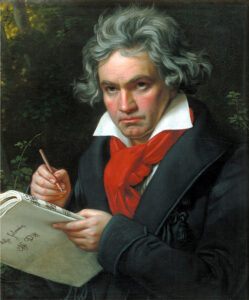
Linus Lerner will conduct the Southern Arizona Symphony Orchestra, SASO Chorus, and soloists in a season-closing presentation of Ludwig van Beethoven’s Symphony No. 9 in d minor, Op. 125, “The Choral.” This work is acknowledged to be the greatest symphony ever composed, and greatly influenced later composers of orchestra music, particularly Brahms and Mahler.
Born in Bonn on December 16, 1770, Beethoven lived in the Age of Enlightenment with great upheavals in political and social beliefs. In his 57 years of life—he died on March 26, 1827—Beethoven became the greatest composer of instrumental music in both form and substance. Each of his nine symphonies established new and profound direction of this form. Prior to the Ninth, he felt that his Third (“Eroica”) was his greatest, but the Fifth has always been most popular, with the Seventh close behind. However, the Ninth was his career-culminating masterpiece; although he could never hear it, he could think it in his mind. If he had been born deaf there would never have been a Beethoven, but his hearing loss was gradual and he was an accomplished musician prior to his loss. He also was the greatest pianist of his time and one of the greatest ever along with Liszt, Chopin, and Rachmaninov. Another gift he had was his ability to improvise/extemporize at the keyboard. He was known to make up new piano parts to his own and others’ concertos without rehearsing them.
After a pattern established by Haydn, the Symphony in d minor is in four movements. At approximately 67 minutes, Op. 125 was very long for its time, but the vast divergence of each movement does not allow the audience to lose focus. Concert posters announced the premiere and in part stated: “Large Musical Academic work by Herr Ludwig van Beethoven on 7 May, 1825 in L.L. Hoftheater (in Vienna) … presents the newest works of L. van Beethoven. First—Great Overture, Second—Three large Hymns with solo and choir voices, Third—Large Symphony with Finale entrance (of) solo and choir voices of Schiller’s Song of Joy. …. Mr. Schuppazich has the direction of the orchestra. … Mr. L. van Beethoven himself will conduct the whole program. …. The entry prices are as usual … free tickets are invalid. The program starts at 7 p.m.”
Note: The overture was Consecration of the House; the hymns were the Kyrie, Credo and Agnus Dei from the Missa Solemnis, of which the church forbad performances at a secular concert; the large symphony was the d-minor Ninth. This was a time when concerts for the public were just starting and could last from three to five hours. I wish to thank Mr. Norman Benecke for translating the above notice from the original German.
Movement 1 is long at 16 minutes; it is serious, somber, articulate, and is in sonata form, which has an introduction, presentation of themes, development of them, recapitulation, and a special ending. In addition there are key and tempo changes, variations, counterpoint, and demands of very dramatic power and sudden subdued passages, all typical of Beethoven. Its finale is a forceful restating of the first theme.
Beethoven chose to have a fast, somewhat humorous second movement where the slow movement would normally appear. This section is a scherzo in 3 time and is known as “the kettledrum joke” as the timpani in octaves have surprise interruptions. Beethoven used solo timpani in numerous works. Theme 1 is a fugue in the strings and is followed by a second theme, also in 3. Following development come a fast trio in 1 time returning to the first theme. The ending is an abrupt four measures.
All of Beethoven’s slow movements are both profound and beautiful, and the Ninth’s is especially so. There are two themes, variations, and profound counterpoint where you hear melody above and below the primary melody.
Following a very sublime third movement, the fourth opens with an explosion and is followed by cello and double bass in an isolated recitative. Now it gets a bit confusing on paper, but not to the ear. There is a series of 12 motifs: the introduction is repeated; theme from the first movement; theme from the second movement; theme from the third movement; a sample of the new fourth-movement theme; and then that entire new theme, but with the returning bass recitative separating each of the above. The opening storm returns and is followed by a baritone singing the recitative. The music now alternates between soloists, chorus, and orchestra. Amid all of this is a military march with triangle, cymbals, and bass drum. The main and stirring theme is Schiller’s “Ode to Joy.” The ending coda for orchestra alone is dramatic and abrupt. This movement does need a blueprint, and how Beethoven conceived it is beyond understanding and relates to pure genius.
There will be three performances: Saturday, May 10 at 7:30 p.m. at DesertView Performing Arts Auditorium in SaddleBrooke; Sunday, May 11 at 3 p.m. in northwest Tucson at St. Andrew’s Presbyterian Church; and Monday, May 12 at 7:30 p.m. at the Pima Community College West Campus Center for the Arts Proscenium Theatre, 2202 W. Anklam Road.
